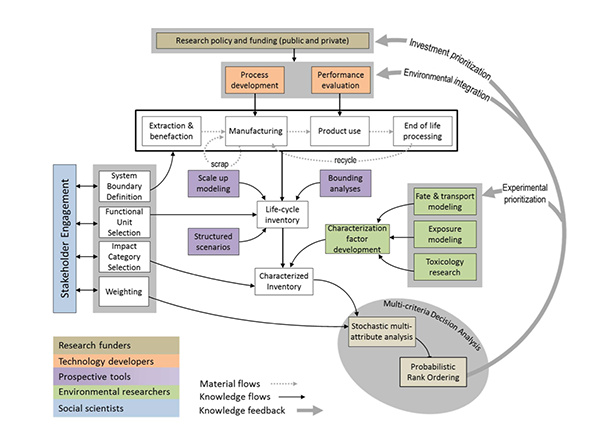Anticipatory LCA: Smarter R&D Without Pain
Life Cycle Assessment (LCA) has become an increasingly useful and popular tool for evaluating products’ environmental impact, and identifying opportunities for reducing associated costs, risks and points of vulnerability.

Life Cycle Assessment (LCA) has become an increasingly useful and popular tool for evaluating products’ environmental impact, and identifying opportunities for reducing associated costs, risks and points of vulnerability.
But what about products that don’t exist yet? What if research and development (R&D) groups could look ahead and identify potential liabilities and other unanticipated consequences of products and technologies early in innovation, and take steps to mitigate these during the development process?
That’s the motivation for Anticipatory LCA, an evolving analytical framework being developed by an interdisciplinary group of researchers from academia, industry and government. It’s part of a wider move towards Responsible Research and Innovation (RRI), and offers a practical tool that can help implement RRI practices within technology developing organizations.
The goal is to integrate environmental criteria into the technology development process in a way that anticipates foreseeable negative consequences, identifies opportunities for improving the environmental profile of emerging technologies, and communicates findings to R&D decision-makers in time to reorient research.

We’re finding interest at companies and government agencies that have been bitten in the past by unexpected environmental liabilities, and those that are mandated to evaluate environmental impacts of new products. More generally, it can help companies broaden the range of values considered in innovation – to formalize tradeoffs, guide and prioritize research, and ultimately develop more successful new products.
Indeed, while avoiding potential liabilities is certainly a motivator, the application of LCA techniques to R & D provides a helpful framework for generating hypotheses and guiding future research investments. It can help technology developers set performance metrics, identify opportunities for improvement in the areas in which they are working, explore and formalize tradeoffs between criteria that different people and groups evaluate in different ways, and prioritize investments to create better outcomes.
One illustrative example is the development of corn-derived ethanol as a gasoline additive. There is obvious appeal in replacing a petroleum product with a renewable, which also generates lower tailpipe emissions of greenhouse gases (GHG). But now, almost two decades into widespread take-up, observers have linked the process to higher food prices in poor countries, water scarcity, fertilizer runoff and water quality impacts. And there are also questions about net GHG improvement when the full life cycle is taken into account.
This is exactly the kind of broad-perspective analysis that LCA is good at, and applying it in advance can uncover a host of unintended consequences – and guide researchers into avenues with better potential.
One fundamental aspect of Anticipatory LCA is that, unlike traditional LCA for existing products, it is designed to introduce uncertainty into the model – because expanding uncertainty and testing model sensitivity to alternative R&D decisions help identify the most environmentally promising research agendas. By considering the wide possible range of results from a technology path, anticipatory LCA can also identify risks along the way.
In this capacity, the framework will generate many models of alternative scenarios, all having high degrees of uncertainty, in order to explore a broad spectrum of possible futures, as opposed to a small set of most-likely outcomes. By helping cultivate awareness of many potential outcomes, anticipatory LCA serves not as a predictor of the future, but as a way of building preparedness for it. It is, thus, an approach that contributes to achieving the broader goals of RRI.
It’s important to remember that Anticipatory LCA is designed from the ground up to be not a drag on innovation, but a fruitful way to interrogate and interact with the R&D process. Innovation is, and always has been, a structured and directed process. And while the adoption of Anticipatory LCA might make that process look a little different, it has tremendous potential to make it more robust and effective.